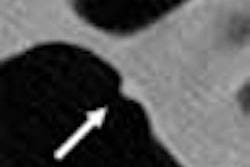Patients who have endured both conventional and virtual colonoscopy exams want virtual the next time around, according to radiologists who kept tabs throughout the process. The preference for virtual persisted even when subjects were told that a positive result would land them another conventional exam anyway.
Dr. Jasper Florie from Amsterdam's Academic Medical Center presented his group's ongoing study at the 2003 European Congress of Radiology. The goal was to find out what patients thought of the various components of the two exams given on the same day, and how their attitudes might evolve over time.
"To measure patient acceptance, we asked patients about ... discomfort, embarrassment, pain, and overall burden on a five-point sliding scale rating from "none" to "severe," and we also asked patients about their preference, from "definitely colonoscopy" to "definitely CT "on a seven-point sliding scale," Florie said.
The first questionnaire was asked two weeks before the procedures, the second after cleansing, the third after CT imaging and the fourth after conventional colonoscopy.
"The fifth questionnaire was sent to the patients five weeks after both examinations," he said, "and we think this more (accurately) reflects the opinions of the patients towards the next screening examination."
All 246 patients (mean age 58, 55% male and 45% female) underwent standard bowel purgation cleansing. They were given buscopan as an antispasmodic agent before CO2 insufflation of the colon, followed by virtual colonoscopy. After prone and supine CT images were acquired, the patients were offered sedation before moving on to conventional colonoscopy, and 65% of them accepted it.
"The first questionnaire (before the exams) asked patients what they feared most," Florie said. "What they feared most was the colonoscopy, after that cleansing, and after that CT colonography. After cleansing, 60% rated the macrogol solution as relatively burdensome."
After virtual colonoscopy, 3.6% of the patients said they experienced considerable to severe pain, with 1.6% rating virtual colonoscopy as severely burdensome, Florie said.
However, "after the CT colonography (VC), 88% said the burden was not higher than expected, and the most burdensome aspect was insertion of the tube and the filling of air," he said. "After (conventional) colonoscopy, 80% said the most burdensome aspect was the movement of the scope."
In all, 36% of the patients reported considerable to severe pain with conventional colonoscopy, and 30% rated its overall burden as severe, far higher than the equivalent virtual exam scores.
After both examinations were completed, the group asked patients what was the single most burdensome aspect of the exams. Cleansing (needed for both procedures) came in at number one, followed by conventional colonoscopy and then virtual colonoscopy, Florie said. The embarrassment levels were the same for both procedures.
"We also asked patients about their preference for the next examination, given that there's a 20% chance for a colonoscopy after CT -- when there are polyps," he said. "More patients would choose (virtual colonoscopy) for their next examination: about 70% (vs.) 20% for colonoscopy right after the examination."
Still, five weeks later virtual colonoscopy had lost 10% of its charm. Having thought things through, 60% of the patients said they would prefer virtual colonoscopy next time and 30% wanted conventional, with 10% not caring either way.
An audience member asked Florie why he thought virtual colonoscopy might have lost ground in those last five weeks, while remaining more popular than colonoscopy.
In five weeks' time "I think that patients forget about the amount of pain and how burdensome (colonoscopy) was," Florie said. And by then, he added, a few more patients might have decided that if there's a 20% chance polyps will be found in VC and they'll need conventional colonoscopy anyway, they might as well start with it.
By Eric BarnesAuntMinnie.com staff writer
May 7, 2003
Related Reading
VC screening trials find good sensitivity, high patient acceptance, October 30, 2002
Toward a CRC screening strategy: gastroenterologists take the stage, June 3, 2002
Copyright © 2003 AuntMinnie.com



















